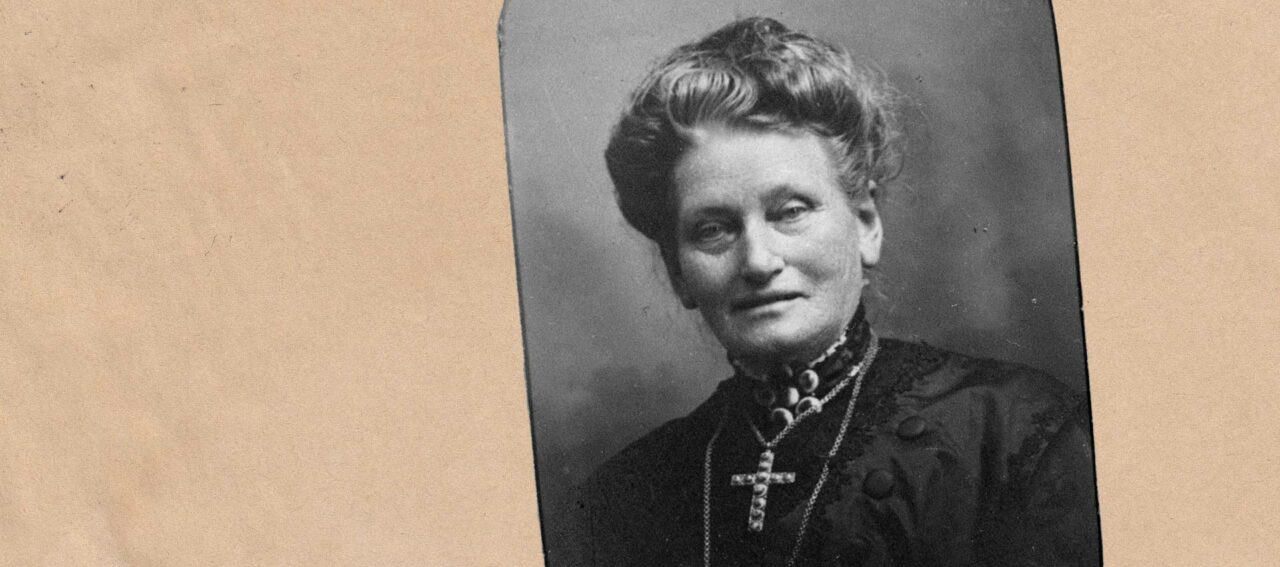Louisa Matilda Buck’s parents and siblings arrived in New Zealand in March 1842 aboard the ship ‘Birman’. Louisa was born in Wellington on 29 January 1844. While in Wellington she met and married George Matthew Snelson in 1865, and the couple lived there for several years.
George moved north to the fledgling settlement of Palmerston – later Palmerston North – in Manawatū to set up a store for new settlers, and Louisa joined him soon after, bringing with her the young ward in their care, Matilda Montgomery. George’s role broadened from mere storekeeper to that of auctioneer and land agent, and Louisa began to involve herself in community affairs in the growing settlement. She taught in the All Saints Anglican Sunday School and appealed to the provincial government to make a grant of land for the building of the first public school.
The growth of Palmerston North seems to have galvanised Louisa into becoming more actively involved in the growing community. She became something of a public figure, attending numerous public gatherings and getting involved in many causes around Palmerston North. Around 1890, Louisa was a member of the exhibition and bazaar committee that lobbied to raise funds for a hospital in Palmerston North. She also began the petition to have a statue of Te Peeti Te Awe Awe erected that was eventually unveiled in 1907
From 1871 the Snelsons actively befriended many in a wave of incoming Scandinavian migrants, with George offering supplies from his shop and the couple providing board in their Fitzherbert Street (now Fitzherbert Avenue) home for several young immigrants needing temporary accommodation. Photographs of many people whom the Snelsons met and got to know have been preserved thanks to a 310-page photograph album compiled by Louisa. It resides in the Ian Matheson City Archives at the Palmerston North City Library.
As a signatory to the petition for women’s suffrage, Louisa would have been keenly aware of the significance of the document she was signing. George, besides being a county and borough councillor, was also a JP and the local registrar of births deaths and marriages, which required him to handle affairs for families and lodge documents with the government in Wellington. For both Louisa and George, community affairs and the welfare of settlers was an important aspect of their public lives, and this brought them into contact with people from a wide variety of backgrounds and circumstances (Louisa is thought to have spoken Te Reo). The couple faced economic hardship in the early 1890s, and George suffered an accompanying period of ill-health. Perhaps the impact of these challenges and what they might mean for her in the event of George’s death was going through Louisa’s mind as she signed the petition, in the hope that its passing would provide a greater degree of political representation, freedom and choice for the women of New Zealand.
George did indeed die in 1901, and Louisa seems to have faced great difficulties afterward. In 1903 she sold “Rangiotu”, their five acre freehold property in Hokowhitu, including house and contents, presumably to support herself. She also lodged applications for permits to auction paintings and ornaments.
Ever community-minded, however, during the First World War Louisa seems to have been behind the organisation of a large consignment of socks, stockings and mittens for Belgian war widows (Manawatū Times, 8 May 1915, page 5), and frequently donated items to the local Patriotic Shop or to the All Saint’s Children’s Home. However in the years prior to her death her health declined and she was frequently in hospital.
Louisa died at Wanganui Hospital on December 14, 1919. The Snelsons had no surviving children – their two children, Frances Mary and George James, had died as infants. Their legacy was a grateful community that the Snelsons had loyally supported and taken a leading role in since its founding. Louisa herself was described in obituaries as “the Mother of Palmerston North”. Snelson Street in Palmerston North is named after the couple, although no other memorial exists.




